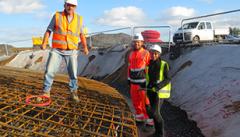
Research
Wind repowering: laboratoire GEOMAS optimises the foundations
About twenty years ago, the first French wind turbines flourished on the hills in the south and the great plains in the north of the country. Today, wind power is the second largest primary source of renewable energy. However, after twenty years of operation, wind farms are in danger of becoming obsolete, causing economic and environmental problems. The FEDRE1 project aims to optimise the foundations of existing wind turbines in the face of the constraints imposed by new equipment, which is more powerful than a few years ago. Meeting with Laurent Briançon, associate professor at laboratoire GEOMAS (Geomechanics, Materials, Structure) and scientific director of the project.
 As onshore wind turbines have a lifespan of between twenty and twenty-five years, the problem of re-equipment is beginning to emerge on French wind farms. For wind farm operators, there is an alternative way to increase energy supply without installing additional wind turbines: ‘repowering’ consists of replacing old equipment with more powerful models. ‘As we will soon reach the maximum number of wind turbines that can be installed in France, the manufacturers propose increasing the power to avoid building new ones, but there are technical constraints to this’, explains Laurent Briançon.
As onshore wind turbines have a lifespan of between twenty and twenty-five years, the problem of re-equipment is beginning to emerge on French wind farms. For wind farm operators, there is an alternative way to increase energy supply without installing additional wind turbines: ‘repowering’ consists of replacing old equipment with more powerful models. ‘As we will soon reach the maximum number of wind turbines that can be installed in France, the manufacturers propose increasing the power to avoid building new ones, but there are technical constraints to this’, explains Laurent Briançon.
Made up of a rotor, a nacelle and a mast, a conventional on-shore wind turbine2 rests on a circular reinforced concrete base with a diameter of about twenty metres. The new equipment offered by repowering is larger, heavier and, above all, more of a burden on the foundation. ‘The current proposed solution to replace the equipment is to deconstruct the entire reinforced concrete footing to build a stronger one to accommodate the new masts. Our team is working to adapt this new equipment to the existing foundations to avoid this costly and environmentally unfriendly solution. It should be noted that the construction of a foundation alone accounts for 10% of the total cost of the wind turbine, and the used concrete blocks are neither reusable nor recyclable because of their scrap density. The tonne of cement needed to manufacture the new footing represents almost 900kg of carbon dioxide. Imagine the number multiplied by the 8000 or so wind turbines installed in France!’
In the next ten years, 50% of Europe's wind farms will have to be re-equipped. The FEDRE project team hopes to participate in improving the integration of wind power in the energy landscape and to improve the competitiveness of the sector. ‘If our solution is viable, we would like to set up an economic interest grouping with the consortium we have formed. The share of renewable energies in the world is still too low compared to fossil fuels. We hope to be able to participate in cleaner repowering of wind turbines’, concludes the laboratoire GEOMAS researcher.
Find out more: http://fedre.insa-lyon.eu/fr
1 Foundations of Sustainable Wind Turbines and Repowering
2 An onshore wind turbine is by definition installed on land and differs from offshore wind turbines installed at sea.

